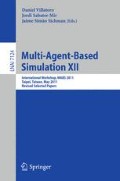Abstract
The aim of this paper is to show how to do social simulation in logic. In order to meet this objective we present a dynamic logic with assignments, tests, sequential and nondeterministic composition, and bounded and non-bounded iteration. We show that our logic allows to represent and reason about a paradigmatic example of social simulation: Schelling’s segregation game. We also build a bridge between social simulation and planning. In particular, we show that the problem of checking whether a given property P (such as segregation) will emerge after n simulation moves is nothing but the planning problem with horizon n, which is widely studied in AI: the problem of verifying whether there exists a plan of length at most n ensuring that a given goal will be achieved.
Access this chapter
Tax calculation will be finalised at checkout
Purchases are for personal use only
Preview
Unable to display preview. Download preview PDF.
References
Baader, F., Calvanese, D., McGuinness, D.L., Nardi, D., Patel-Schneider, P.F. (eds.): Description Logic Handbook. Cambridge University Press (2003)
van Benthem, J., van Eijck, J., Kooi, B.: Logics of communication and change. Information and Computation 204, 1620–1662 (2006)
Bylander, T.: The computational complexity of propositional strips planning. Artificial Intelligence 69, 165–204 (1994)
Chapman, D.: Planning for conjunctive goals. Artificial Intelligence 32(3), 333–377 (1987)
Conte, R., Paolucci, M.: Responsibility for societies of agents. Journal of Artificial Societies and Social Simulation 7(4) (2004)
Cultien, C.: Implementing dynamic logic of propositional assignments in a QBF solver. Master’s thesis, Université de Toulouse (September 2011)
Dignum, F., Edmonds, B., Sonenberg, L.: Editorial: The Use of Logic in Agent-Based Social Simulation. Journal of Artificial Societies and Social Simulation 7(4) (2004)
van Ditmarsch, H.P., van der Hoek, W., Kooi, B.: Dynamic epistemic logic with assignment. In: Proceedings of AAMAS 2005, pp. 141–148. ACM Press (2005)
Edmonds, B.: How Formal Logic Can Fail to Be Useful for Modelling or Designing MAS. In: Lindemann, G., Moldt, D., Paolucci, M. (eds.) RASTA 2002. LNCS (LNAI), vol. 2934, pp. 1–15. Springer, Heidelberg (2004)
Fasli, M.: Formal systems and agent-based social simulation equals null? Journal of Artificial Societies and Social Simulation 7(4) (2004)
Fattorosi-Barnaba, M., de Caro, F.: Graded modalities I. Studia Logica 44, 197–221 (1985)
Garey, M.R., Johnson, D.S.: Computers and Intractability: A Guide to the Theory of NP-Completeness. W. H. Freeman Co. (1979)
Harel, D., Kozen, D., Tiuryn, J.: Dynamic Logic. MIT Press, Cambridge (2000)
Horrocks, I.: Using an expressive description logic: Fact or fiction? In: Proceedings of KR 1998, pp. 636–649 (1998)
Kautz, H.A., Selman, B.: Planning as satisfiability. In: Proceedings of ECAI 1992, pp. 359–363 (1992)
Reiter, R.: Knowledge in Action: Logical Foundations for Specifying and Implementing Dynamical Systems. MIT Press (2001)
Schelling, T.C.: Dynamic Models of Segregation. Journal of Mathematical Sociology 1, 143–186 (1971)
Shanahan, M.: Solving the frame problem: a mathematical investigation of the common sense law of inertia. MIT Press (1997)
Taillandier, P., Drogoul, A., Vo, D.A., Amouroux, E.: GAMA: a simulation platform that integrates geographical information data, agent-based modeling and multi-scale control. In: Proceedings of PRIMA 2010 (2010)
Thielscher, M.: The logic of dynamic systems. In: Proceedings of the 14th International Joint Conference on Artificial Intelligence (IJCAI 1995), Montreal, Canada, pp. 1956–1962 (1995)
van der Hoek, W.: On the semantics of graded modalities. Journal of Applied Non-Classical Logics 2(1) (1992)
van Eijck, J.: Making things happen. Studia Logica 66(1), 41–58 (2000)
Wilensky, U.: Netlogo segregation model. Technical report, Center for Connected Learning and Computer-Based Modeling. Northwestern University, Evanston, IL (1997)
Wilensky, U.: Netlogo. Technical report, Center for Connected Learning and Computer-Based Modeling. Northwestern University, Evanston, IL (1999)
Author information
Authors and Affiliations
Editor information
Editors and Affiliations
Rights and permissions
Copyright information
© 2012 Springer-Verlag Berlin Heidelberg
About this paper
Cite this paper
Gaudou, B., Herzig, A., Lorini, E., Sibertin-Blanc, C. (2012). How to Do Social Simulation in Logic: Modelling the Segregation Game in a Dynamic Logic of Assignments. In: Villatoro, D., Sabater-Mir, J., Sichman, J.S. (eds) Multi-Agent-Based Simulation XII. MABS 2011. Lecture Notes in Computer Science(), vol 7124. Springer, Berlin, Heidelberg. https://doi.org/10.1007/978-3-642-28400-7_5
Download citation
DOI: https://doi.org/10.1007/978-3-642-28400-7_5
Publisher Name: Springer, Berlin, Heidelberg
Print ISBN: 978-3-642-28399-4
Online ISBN: 978-3-642-28400-7
eBook Packages: Computer ScienceComputer Science (R0)

